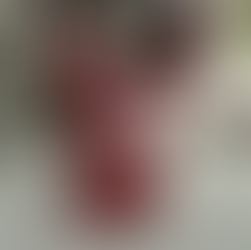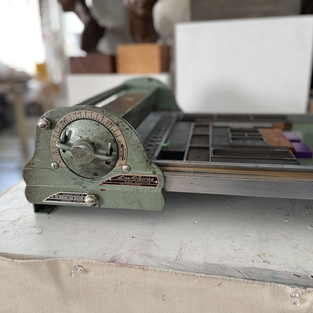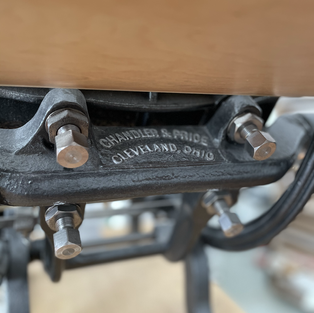Meet the Team! Part 1
- Phoebe Todd-Parrish

- Jan 29, 2021
- 4 min read
Flycatcher Press is only 1 person, but I'd like to introduce our inanimate cast-iron and steel coworkers. In this first instalment I will be going over our fine array of letterpresses! Part 2 will be our etching presses + some extra bits. Let's start from smallest of the bunch, shall we? Adana No. 3
The Adana is a platen press, and often referred to as the "The Adana 8x 5". The 8" x 5" is the inner dimension of the chase (where you lock up the type for printing). This little red cutie weighs about 50 or 60 lbs so it the lightest of the bunch, which is nice for portability. The Adana is a great press for workshops, or printing small items like cards. I'm not sure when this particular press was produced, but it is an older model. While The Adana stopped being manufactured in the 1970s, there are still many on the internet, either in used condition or beautifully restored. Mine is the former, but she does the trick for quick jobs that don't need hyper-precision. Adanas were made in Twickenham, England, and this model is the No. 3 (of 3 produced). You can read more about Adana presses on the Letterpress commons website here. Line-o-scribe
The line-o-scribe is a type of flat-bed press, but more specifically a "show-card" style of letterpress. These are superficially similar to, but not at all the same as, proof presses like our Challenge press (below). The line-o-scribe, and other models that are similar in simplicity and functionality, were marketed toward department stores. With one of these babies, stores could print their own signs: think old-school, sears-esque department store basements, stressed and sweaty floor managers, needing to a whip up a quick "Socks on sale: 5 pairs for .50 cents" type of thing. This style of press was meant to eschew the need for employing a show-card painter, who would paint all the signs for a store by hand. Our particular press was manufactured by the Morgan Sign Machine Co, in Chicago, Illinois. My best guess is that this press was made sometime in the 1950s. I acquired this press from a collector, who had purchased it from a man whose business was selling "personalized" newspapers to tourists in Niagara Falls. When I picked up the press, it also came with about 10, 40lb boxes brimming with fake newspapers with space to print personalized headlines (ex "The Smiths Fall into the Falls!"). This is how a gentleman earned his living!? Very weird. We took many of the boxes, not knowing what we'd do with them - but in the end we recycled them due to the outdated nature of the text. (I wish I had a photo of the newspapers but I can't seem to find one!) Aside from the useless boxes of faux-newspapers, when I bought this press, it also came with a pretty lucrative add-on: an incredibly complete, type case filled with beautiful alternate gothic 2" wood type (12 line) and lots of spacing to boot! I use this press all the time, as it is a quick way to ink up type or blocks for printing a short run. This press does have an inking roller, but I don't use it - I use this press when I am inking the type or block with a hand-held brayer. The printing area is very generous on this wide and extra long bed of 14" x 22"- perfect for posters! Challenge Proof Press 1528KA
A true proof press in all her heaving glory! This one is a dooooozy. Acquired from a fellow printer All Sorts Press (see the previous blog post about moving this bad boy here), the Challenge proof press is our chunkiest boy, weighing in at 800lbs (or so). This press has a lot of interesting attributes. Produced by the Challenge Machinery Company in Grand Haven, Michigan, and sold by the American Type Founders (ATF). These presses were manufactured between 1935 and 1973. Popular models of proof presses you will come across if you're looking to buy one, or use one in a local print studio will be varying models of Vandercooks. Challenge proof presses are similar, but a few things make this particular model (K) press different than most others you will encounter. Firstly, the press bed is reciprocating, ie it moves back and forth, while the carriage/cylinder is stationary. This is a funny quirk that makes this press need a lot of extra room because the bed extends out in the front. You can watch a video of me printing the Spark posters to see how the bed moves. The other funny thing about this press, is that it does have an inking system but it is still manual. You can see it on the photo above on the right - you basically hand-crank so the ink distributes over all of the rollers, then when the press is in "trip" (inking) mode - the rollers are down, and you can ink the type without printing at the same time. You can find an incomplete consensus of the remaining Challenge presses here. Chandler and Price Pilot Press
This humble monster is a beautiful specimen indeed. Weighing about 160-200lbs the Pilot press is made of cast-iron. It was produced by Chandler & Price in Cleveland Ohio. This particular press is probably over 100 years old, but it has been restored and well-taken care of over the years.
These presses are considered to be the best table-top (on a strong table of course) platen presses every made. This pilot has a chase size of 6.5" x 10" so it is well suited to invitations, greeting cards, small broadsides, notebooks and business cards. The clinking of this press in action is quite a sight and sound to behold.




























Comments